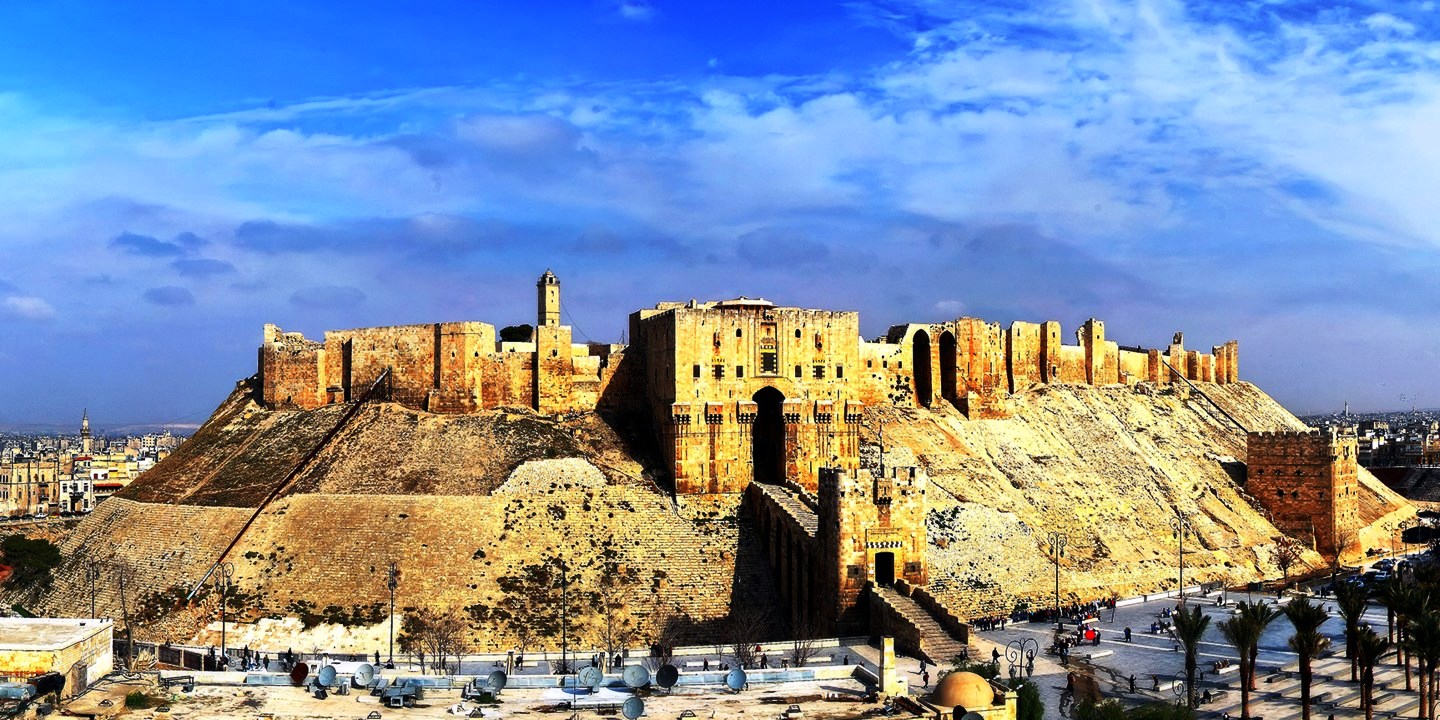Aleppo Citadel: A Majestic Fortress Through the Ages: The Aleppo Citadel, one of the oldest and most impressive castles in the world, rises dramatically above the heart of Aleppo, Syria. This UNESCO World Heritage Site, the Aleppo Citadel, has witnessed thousands of years of history, bearing the marks of numerous civilizations, empires, and conflicts. For travelers seeking to explore the rich tapestry of Syrian culture, history, and architecture, a visit to the Aleppo Citadel is an unforgettable journey into the past.
Aleppo Citadel | Quick Info
| Topic | Quick Info |
|---|---|
| Name | Aleppo Citadel / قلعة حلب |
| Location | Aleppo, Syria – center of the Old City |
| Built | Original fortifications: 3rd millennium BCE; major Islamic-era construction: 12th–16th CE |
| Founder / Patron | Multiple rulers: early Akkadian, Ayyubid Sultan al-Zahir al-Ghazi, Mamluks |
| Original Function | Military fortress and defensive stronghold |
| Later / Current Use | Archaeological site and tourist attraction; UNESCO World Heritage Site |
| Architectural Highlights | Massive walls, moats, grand entrance, towers, Ayyubid and Mamluk palaces within the citadel, Islamic-era mosques |
| Significance | One of the oldest and largest citadels in the world; key historical and strategic landmark of Aleppo |
Where Is the Citadel of Aleppo?
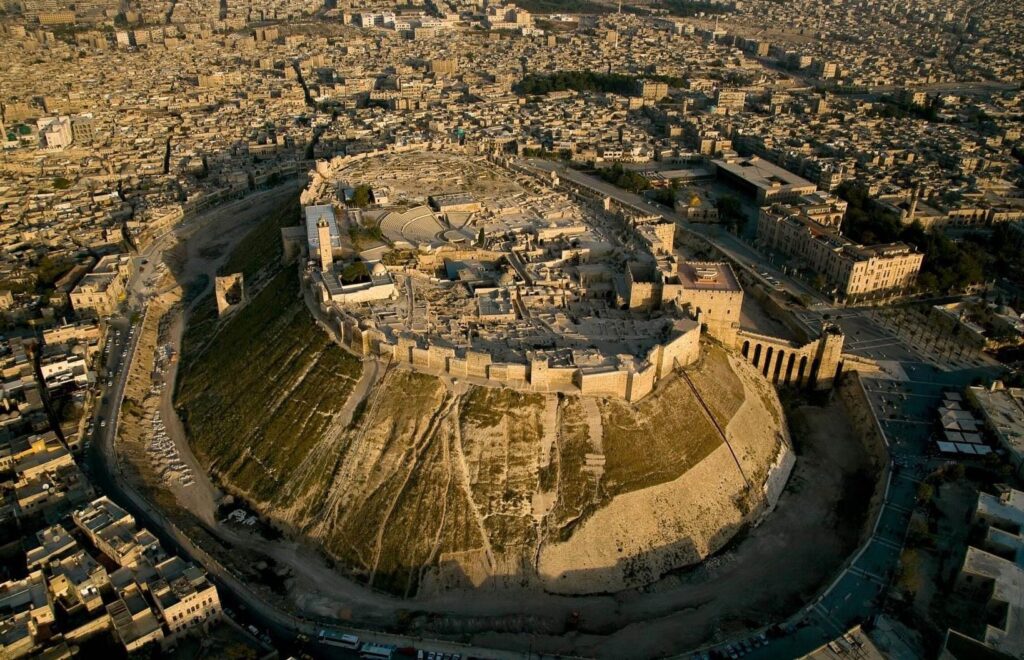
The Aleppo Citadel is located in the center of Aleppo, Syria’s second-largest city. Positioned atop a 50-meter-high hill, it dominates the skyline and is visible from many parts of the city. Its strategic location made it an important military and administrative center throughout the ages. It is easily accessible from various parts of the old city and is surrounded by bustling souks, ancient mosques, and traditional homes.
A Brief Historical Overview

Prehistoric Origins
Archaeological evidence suggests that the hill on which the Aleppo Citadel stands has been inhabited since at least the 3rd millennium BCE. It began as a religious center in ancient times, possibly dedicated to storm gods of the region. Excavations have revealed remnants of temples and palaces beneath the current structure.
Greek and Roman Influence

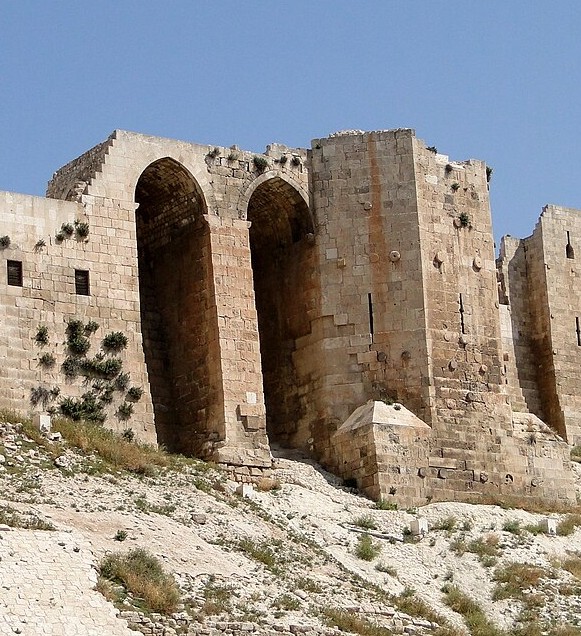
During the Hellenistic period, Aleppo was known as Beroea. The Aleppo Citadel hill likely served as an acropolis, and under Roman rule, the area maintained its strategic importance. Though little architecture remains from this time, the foundation of the fortress was strengthened and utilized in subsequent eras.
Islamic Golden Age
The Aleppo Citadel as we know it today began to take shape during the Islamic period, particularly under the Zengid and Ayyubid dynasties (12th–13th centuries). Sultan al-Zahir Ghazi, the son of the legendary Saladin, was responsible for significant renovations and expansions. Defensive walls, the grand entrance, and various towers were added, transforming it into a formidable military complex.
Mamluks and Ottomans


The Aleppo Citadel was further modified and maintained by the Mamluks and later the Ottoman Empire. They added mosques, barracks, granaries, and a hammam (bathhouse), adapting the fortress for both military and civic uses. Despite being used less as a military stronghold during the Ottoman period, it remained a symbol of power and prestige.
Modern Era and Syrian Conflict
Before the Syrian Civil War, the Aleppo Citadel was a major tourist destination. However, like much of Aleppo, it suffered damage during the war, especially between 2012 and 2016. Parts of the Citadel were affected by shelling and clashes, but restoration efforts have been underway in recent years to preserve its grandeur.
What to See Inside the Citadel

The Iconic Entrance Bridge and Gate Tower
Your journey begins by crossing a stone bridge supported by massive pointed arches. This bridge leads to a monumental Gate Tower, designed with multiple turns to slow down invaders and enhance defense. The entrance itself is richly decorated with Islamic motifs, inscriptions, and stone carvings.
The Ayyubid Palace
One of the architectural highlights is the Ayyubid Palace, believed to have been the residence of Sultan al-Zahir Ghazi. Although partly ruined, it still showcases traditional Islamic design and layout, with inner courtyards and elaborate archways.
The Mosque of Ibrahim
This small mosque is thought to stand on the location where Prophet Abraham (Ibrahim) once prayed. Though the current structure is from the Islamic era, it sits atop a much older religious site and remains a place of spiritual significance.
The Throne Hall
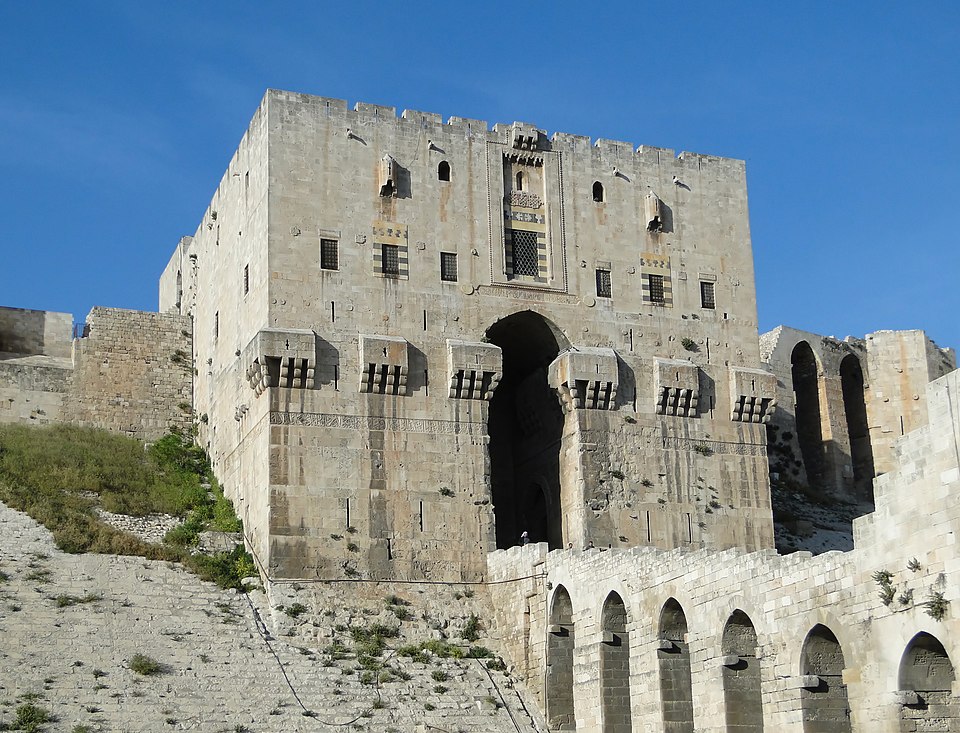
This grand hall was likely used for formal receptions and ceremonies. With its high ceilings and remnants of intricate decoration, it gives a glimpse into the grandeur of medieval Islamic governance.
Underground Tunnels and Storage Areas
The Citadel contains an impressive network of underground passageways, water cisterns, and storerooms. These features allowed the fortress to survive sieges and supply its inhabitants with food and water for extended periods.
Hammam and Public Facilities
You can still see the remains of a bathhouse (hammam), military barracks, kitchens, and grain storage rooms. These facilities reflect the Citadel’s ability to function as a self-sustaining mini-city in times of war.
Practical Tips for Visitors
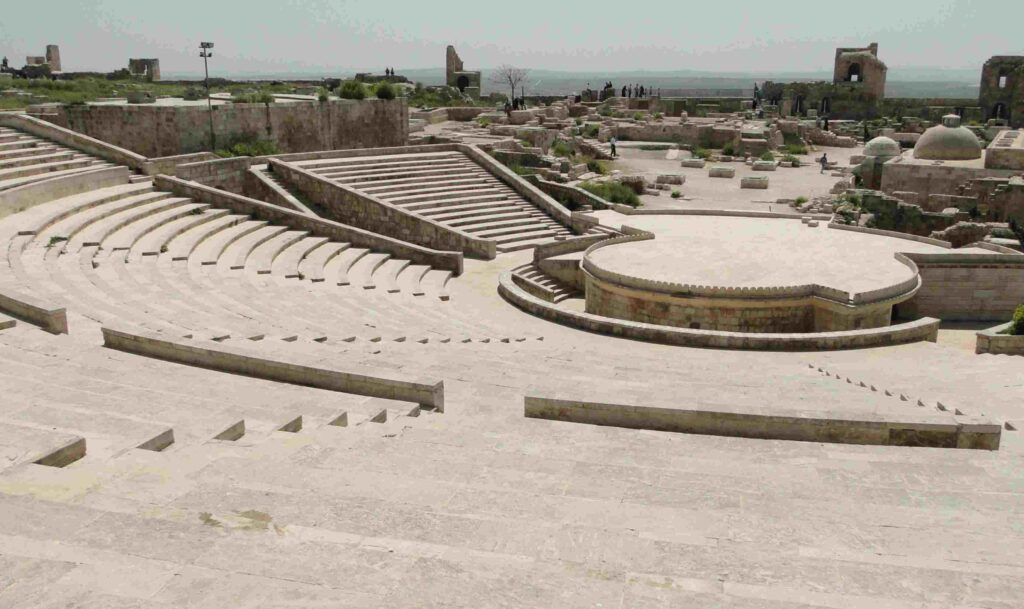
Opening Hours
Before visiting, check with local tourism authorities or online sources, as hours may vary due to restoration work or security concerns. Typically, the Citadel is open from 9:00 AM to 5:00 PM, but may close on certain holidays or during political unrest.
Entrance Fee
Entrance fees are relatively modest for foreign tourists. Fees may differ for locals and foreigners. Expect to pay around 1,000–2,000 Syrian Pounds, although this may change with time and inflation.
Best Time to Visit
The best time to visit Aleppo is during spring (March to May) or autumn (September to November), when temperatures are pleasant. Summer can be very hot, while winters can be cold and rainy.
What to Wear
While there’s no strict dress code inside the Citadel, modest clothing is recommended out of respect for local customs and due to the religious structures within the site. Comfortable walking shoes are essential, as the paths are uneven and involve some climbing.
Guided Tours
Hiring a local guide can enhance your experience significantly. Many guides speak English or French and offer rich historical context and local stories you wouldn’t find in guidebooks. If you’re exploring solo, bringing a reliable printed or digital guide is a great alternative.
Nearby Attractions Worth Visiting
Al-Madina Souq
Just steps from the Citadel is Al-Madina Souq, one of the largest covered markets in the world. Although partially damaged, restoration work is ongoing. It’s a great place to shop for spices, textiles, soaps, and souvenirs.
Great Mosque of Aleppo
Located nearby, the Umayyad Mosque (Great Mosque of Aleppo) is another UNESCO-listed site. Though significantly damaged, its ancient minaret and large courtyard are being restored.
Khan al-Wazir and Other Caravanserais
Aleppo was a major hub on the Silk Road, and many khans (caravanserais) still stand around the Citadel. These were once inns for traders and now serve as reminders of Aleppo’s commercial past.
Cultural Etiquette and Safety
While Aleppo is gradually recovering, tourists should stay informed about the security situation. Always check with your embassy or local travel advisories before planning a visit. Syrians are known for their hospitality, but it’s important to be respectful, especially around religious sites and during prayer times. Photography is generally allowed, but always ask before taking pictures of people, especially women.
Restoration and the Future of the Citadel
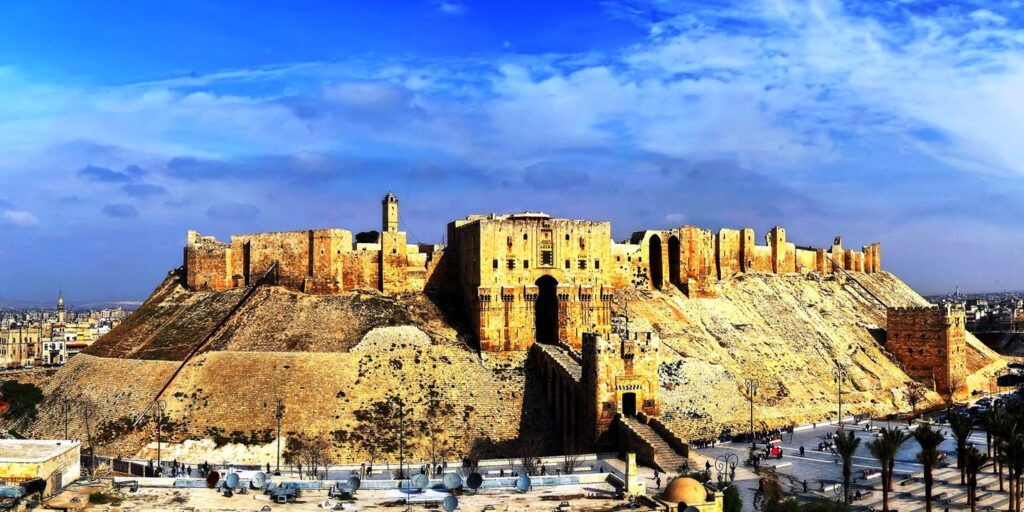
Despite the war damage, the Citadel of Aleppo remains a symbol of Syrian resilience. Restoration projects by UNESCO and local authorities are ongoing, aiming to preserve its legacy and gradually reopen more areas to the public. Every stone that is repaired is a step toward cultural revival and peace.
Conclusion
A visit to the Aleppo Citadel is not just a tour of an ancient fortress—it’s a walk through the soul of one of the oldest continuously inhabited cities on Earth. Its towering walls, majestic gates, and historic halls tell the story of civilizations that rose, flourished, and fell—leaving behind a legacy carved in stone. For those who love history, architecture, or simply the romance of the ancient world, the Aleppo Citadel is a must-visit treasure that promises both awe and reflection.
Finally.. If you have any questions, please contact us. To explore further, visit our Facebook Syria collection for rare images and cultural highlights.
Sources & References:
UNESCO – World Heritage Centre: https://whc.unesco.org
Archnet – Architecture & Heritage Database: https://www.archnet.org
World History Encyclopedia: https://www.worldhistory.org
Syrian Heritage Archive Project: https://syrian-heritage.org
Wikipedia Global Encyclopedia: Wikipedia



